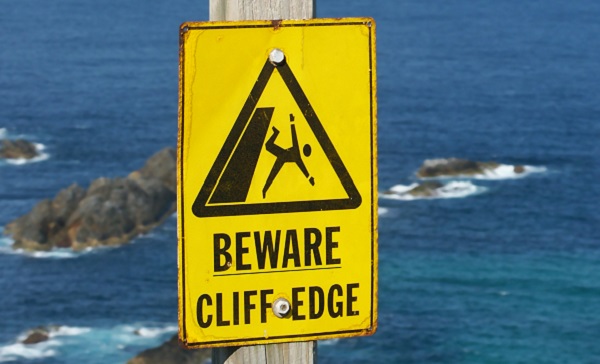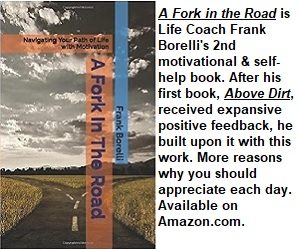Past experience has shown that all of us have times in our life where we feel like we’re “close to the edge.” That edge is usually visualized or shown in images as a cliff, most often with an ocean or other large body of water at the bottom. In a variety of conversations held with people who say they are getting “close to the edge,” and indicating that they’re close to going over that edge, whatever it may represent, it’s become clear that none of them consider changing course. They seem to have in their mind that they have to either keep going as they are, and go over that cliff, or they have to stop where they are… or, on rare occasions, they think they can turn back and move away from the edge.

Unfortunately, there are professions and circumstances that don’t allow the option of just stop, or turn around, and it’s not good when anyone goes over that edge. But what other options are there?
Remembering past experiences that have tested us mentally, emotionally and physically, we can likely all remember a time when we felt that we were on that edge; we were on the verge of breaking; we just didn’t know how we could go on. We can also all probably remember times we kept going on anyway. A personal example I’d use would be a force march I had to complete during the Military Police Academy. 20 miles in, carrying a full ruck sack, equipment belt/vest and weapon, I was sure I couldn’t go on. Two miles later, I was still pushing. Two miles after that, I was still going. I was near in tears and felt like I would soon collapse. I just wanted to quit. I didn’t know how much more I could take. A mile later… we were done. I was in tears. I had busted blisters that had been bleeding but I didn’t know it until I took my boots off. I was sure I would never walk again and I had been so close to quitting it wasn’t funny.
 Looking back at it now I realized that, mentally, what I’d done was slowly start to curve my path as I got closer to the edge. I was no longer going straight for it, but stopping wasn’t an option and I certainly couldn’t turn around and go back. So I adjusted course, and while I could feel myself getting closer and closer to the edge, I was no longer looking at its approach as both inevitable and unavoidable.
Looking back at it now I realized that, mentally, what I’d done was slowly start to curve my path as I got closer to the edge. I was no longer going straight for it, but stopping wasn’t an option and I certainly couldn’t turn around and go back. So I adjusted course, and while I could feel myself getting closer and closer to the edge, I was no longer looking at its approach as both inevitable and unavoidable.
The curve adjusted so that I was just barely not parallel to the edge. I was still getting closer to it with every step, but I wasn’t going over. Mentally and emotionally I was doing whatever was necessary to just stay up on that cliff; not falling over; not tipping; precariously balanced with every step, but NOT going over the edge.
That course of action, and the title of this piece, is paralleling the edge. It’s finding that “sweet spot” that is anything but sweet but keeps you from going over. It keeps you functioning. It keeps you alive. It keeps you sane. It’s the maximum effort you can stand and not go over. It’s the maximum stress you can stand and not go over. It’s the maximum emotional saturation you can stand… and not go over the edge.
Now, how long can you maintain that? None of us should ever want to find out. There are professions out there who embrace finding out. Army Special Forces and Navy Special Warfare are two examples I’d give. Green Berets and Navy SEALs seem to thrive on finding out just how far they can go for how long and then they back off, unwind, let loose, recover and go test themselves again. It takes a special kind of person to do that.
 Throughout the course of our lives, we all find ourselves along that edge. All of us, whether we realized what we were doing or not, have adjusted our course and kept on going, carefully balanced so we don’t go over the edge. It’s a dangerous place to be for very long because you just never know what’s going to come along and push you off balance. You never know what will happen, and it could be the smallest change of circumstance, the tiniest additional challenge, and oops… there you go over the edge. So paralleling the edge is not a good place to be for long, but if you have no choice in being there, it’s a far sight better than going over the edge.
Throughout the course of our lives, we all find ourselves along that edge. All of us, whether we realized what we were doing or not, have adjusted our course and kept on going, carefully balanced so we don’t go over the edge. It’s a dangerous place to be for very long because you just never know what’s going to come along and push you off balance. You never know what will happen, and it could be the smallest change of circumstance, the tiniest additional challenge, and oops… there you go over the edge. So paralleling the edge is not a good place to be for long, but if you have no choice in being there, it’s a far sight better than going over the edge.
Once you have gotten where you need to be… the challenges have passed… you have completed whatever tasks you had to complete… Then is the time to make a hard turn, perpendicular to the edge and move away at best speed. That is visualized as running away from the edge but actually represents recovery. The farther you get from that edge, the healthier you are mentally and emotionally. Physically, we all recover. Mentally and emotionally, the recovery is different and can take much longer. The farther we are from the edge, both in distance and time, the deeper that recovery can be.
The trick is to not go over the edge; to adjust course and approach it more slowly; to move parallel to it if you must, but not to go over it… ever.
